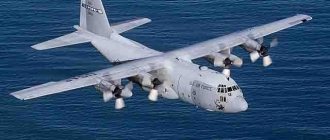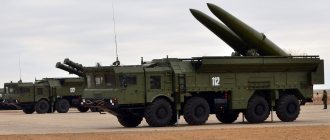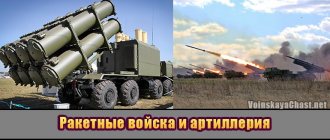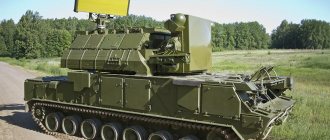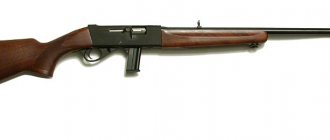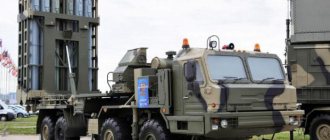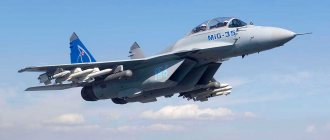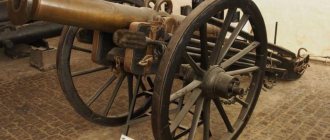The SS-26 Iskander is an operational-tactical missile system designed to eliminate area and small-sized targets that may be located deep in the operational location of enemy troops. The Iskander operational-tactical missile system was destined to be created in an environment in which the 1987 Short- and Medium-Range Nuclear Forces Treaty was in force. In addition, there was a refusal to use nuclear weapons in war between opposing sides.
This is precisely why the Iskanders were created, taking into account the new requirements placed on them:
- The use of a warhead only in the presence of standard equipment;
- Refusal of nuclear strikes;
- Guiding missiles along all their flight trajectories;
- High firing accuracy;
- The likelihood of changing combat units, taking into account the types of targets being eliminated;
- High level of automation of all processes.
Some information from the history of the Iskanders
Iskanders were developed simultaneously with the help of several design bureaus and institutes. However, the Kolomna Mashinostroeniya Design Bureau was destined to become the parent enterprise. It is known for many legendary weapons, such as Tochka-U, Igloy and Arena air defense systems, as well as many Soviet and Russian mortars.
The development of Iskander began with S.P. Invincible, the legendary general designer. He took the very successful RK Oka as a basis for that period. It is known that Oka was the first in history that was able to pass through missile defense with a coefficient of almost one, which ensured a high probability of hitting the target. However, according to the 1987 treaty between the USSR and the USA, they were destroyed. New developments were assigned to Valery Kashin, the current general designer and head of the Mashinostroeniya design bureau.
KBM was given a task: the new complex should destroy any targets, stationary or moving. And this is with the main requirement - the highest degree of missile defense penetration with target destruction, but without nuclear charges.
Passing the missile defense was based on:
- Maximum reduction of the missile dispersion surface. Their contours have become extremely streamlined and smooth;
- The external surfaces were treated with a radio-absorbing special coating;
- The ability to quickly and actively maneuver, as a result of which the Iskander trajectory is unpredictable and missile interception is impossible.
No other operational-tactical and tactical missiles built on the planet have similar properties. During the development process, the designers performed absolutely unique work. This led to a revision of many of the concepts contained in the preliminary sketches of the project.
After the February 1993 Decree of the Russian President related to development work on the Iskander M complex, a tactical and technical specification was prepared. It indicated new approaches to the construction of complexes, as well as the optimization of all solutions.
For this reason, Iskander M had to become a completely new complex, and not a modernized old one. The complex has become the focus of numerous advanced domestic and world scientific achievements. Climatic, flight and bench tests had to drag on for many years. Mostly everything was carried out in Kapustin Yar, but some were also in other regions of the state.
Mid-autumn 2011 was marked by the completion of the first stage of tests carried out with the Iskander-M missile system, which resulted in the receipt of new combat equipment. The 9M723 missiles had excellent characteristics, as well as a new correlation guidance system.
Drones will help
The most effective use of missile units is as part of reconnaissance and strike complexes (RUK). The reconnaissance aircraft detects the target, transmits information to the command post of the formation, after which the object is destroyed. The entire process from the moment of detection to the moment of impact takes several minutes. Moreover, the capabilities of Iskander brigades to search for targets were seriously expanded last year.
They featured Orlan-10 multifunctional long-range drones and quadcopters. Unmanned aircraft have made missile units more autonomous. "Eagles" allow you to independently find targets on the battlefield and aim missile systems at them in real time, as well as broadcast the results of attacks. Modern military clashes require maximum decision-making speed, and the presence of our own reconnaissance means allows us to respond almost instantly to emerging threats.
Lightweight quadcopters perform protective functions - they guard missile launchers. They will come in handy both in peacetime and in wartime. When accompanying convoys and in combat positions, they can look out for enemy saboteurs using optical equipment. These devices are also equipped with systems that detect electronic radiation, which makes it possible to find saboteurs if they use the connection.
The rocket scientists got their first experience using quadcopters this year. During the exercises in Transbaikalia, drone operators monitored the terrain in the area of movement of the Iskanders of the Eastern Military District brigade and looked for suitable sites for equipping firing positions.
This year, Iskanders were connected to the “military Internet”. Now the calculation of the complex in real time can receive a ready-made flight mission (data on target coordinates and flight path) and attack the enemy within a minute. Moreover, the Iskanders can be controlled by both the brigade commander or spotters, and the Minister of Defense - the order can be given both from the front edge of the front line and from the National Defense Control Center in Moscow. Previously, data about the target was sent to a special divisional machine, where the missile flight was calculated, after which the task was transferred to a specific launcher.
Izvestia Help
The Iskander OTRK was developed in the late 1980s and early 1990s to replace the Tochka and Tochka-U tactical missiles and entered service in 2006. The last brigade still equipped with Soviet missiles was rearmed this year. This missile system is capable of hitting point targets at a distance of up to 500 km with a high-explosive, cluster or thermobaric warhead. The operating temperature range is from minus 50 to plus 50 degrees. You can get your vehicle into combat readiness after a march in 16 minutes.
Characteristic features of the Iskanders
The characteristic features of the Iskanders are:
- Availability of high-precision effective destruction of a wide variety of targets;
- Stealth in combat duty, in preparation for launch and in delivering strikes;
- Automation of calculations and input of flight missions for missiles at launchers;
- High potential for performing combat missions in an environment of active counteraction by the enemy;
- High level of operational reliability of missiles, trouble-free launch and flight;
- High level of tactical maneuverability;
- High level of strategic mobility;
- High level of automation of processes in the combat control of missile units;
- Fast processing and timely delivery of intelligence data to the necessary levels of management;
- Long service life and convenient operation.
What is the Iskander operational-tactical missile system?
OTRK "Iskander" is designed to destroy:
- enemy air targets;
Question answerHow does the S-400 Triumph anti-aircraft missile system work? Infographics
- enemy long-range artillery;
- enemy infrastructure facilities.
The complex can carry nuclear weapons.
The most likely targets of the Iskander OTRK:
- fire weapons (missile systems, multiple launch rocket systems, long-range artillery);
- missile defense and air defense systems;
- airplanes and helicopters at airfields;
- command posts and communication centers;
- critical civil infrastructure facilities.
Combat characteristics
The combat characteristics of the Iskanders are:
- Circular deviation probability: 1-30 m;
- The launch weight of the rockets is 3,800 kg;
- Length – 7.2 m;
- Diameter – 920 mm;
- Weight of warheads – 480 kg;
- The rocket speed after the initial part of the trajectory is 2100 m/s;
- The minimum target engagement range is 50 km;
- Maximum target engagement range: 500 km – Iskander-K;
- 280 km – Iskander-E.
Regulation and maintenance machine (MRTO) OTRK "Iskander"
It is placed on the chassis of the Kamaz family and is intended for routine checks of on-board equipment of missiles placed on TZM (as well as in containers), checks of instruments included in group sets of spare parts for complex elements and routine repair of missiles by the MTO crew. Vehicle weight - 13500 kg, deployment time - 20 minutes, automated cycle time for routine check of on-board rocket equipment - 18 minutes, crew - 2 people.
Elements that make up the Iskander
The main elements that make up the Iskander are:
- Rockets;
- Self-propelled launchers;
- Transport-charging vehicles;
- Routine maintenance vehicles;
- Command and staff vehicles;
- Data preparation points;
- Arsenal equipment sets;
- Educational and training aids.
Self-propelled launchers - designed for storage, transportation, preparatory work and launches at targets of two missiles (in the export version of one missile). Self-propelled launchers can be made on the basis of special wheeled chassis, which are produced at the Minsk Wheel Tractor Plant. The tractors have a total weight of 42 tons, a payload of 19 tons, a travel speed of 70 km/h on highways, 40 km/h on dirt roads, and a fuel range of up to 1000 km. The combat crew includes three military personnel.
Transport-loading vehicles are designed to transport an additional pair of missiles. Transport-loading vehicles are based on the MZKT-7930 chassis and are equipped with loading cranes. They have a total combat weight of 40 tons and a crew of two military personnel.
Command and staff vehicles are designed to control all processes in the Iskander complexes. They are based on the KamAZ-43101 wheeled chassis. The combat crew includes four military personnel.
Characteristic features that the CVS have:
- The maximum radio communication range on the spot is 350 km, on the march 50 km;
- Estimated task time for missiles is up to 10 s;
- Command transmission time up to 15 s;
- The number of radio communication channels is 16;
- Unfolding (collapsing) time is up to half an hour;
- Continuous operation time up to two days.
Routine and maintenance vehicles are designed to monitor instruments, missiles, on-board equipment and to carry out routine repair work. They are located on the KamAZ wheelbase. They have a mass of up to 14 tons, a deployment time of no more than 20 minutes, a time of automated cycles of routine checks of on-board missile equipment - 18 minutes, and a combat crew of two military personnel.
Data preparation points are designed to determine the coordinates of targets and prepare data for missiles in order to transmit them to the SPU. Data preparation points are integrated with intelligence assets and can receive tasks from any sources, including satellites, aircraft or drones. There are two military personnel in the combat crew.
Life support vehicles are designed for combat crews to rest and eat. They are located on the wheelbase of KamAZ-43118. The machines have: compartments for rest and compartments for household supplies.
Iskander missiles are solid-fuel, single-stage, with warheads that cannot be separated in flight, guided and maneuverable missiles along the entire length of difficult-to-predict flight trajectories. Missiles maneuver especially quickly during the starting and final stages of flight, in which they approach targets with high overloads.
This is due to the need to fly anti-missile missiles to intercept Iskander missiles with overloads two to three times greater, which today is considered almost impossible.
Most of the flight trajectories of the Iskander missiles were carried out using stealth technologies with small reflective surfaces. The “invisibility” effects are ensured by the combined design features of the missiles and the treatment of their surfaces using special coatings.
The launch of missiles to targets is carried out using an inertial control system. They are subsequently captured by autonomous correlation-extreme optical homing heads. The missile homing system operates on the principle that optical instruments form images in the target area, which the on-board computer compares with the data entered into it.
Optical homing heads are distinguished by an increased level of sensitivity and resistance to existing electronic warfare equipment. Thanks to this, you can launch missiles on a moonless night without additional natural illumination and eliminate moving targets within a radius of two meters. Today, such tasks, except for the Iskanders, cannot be solved by any other similar missile systems on the planet.
It is interesting that the optical homing systems used in missiles do not need to correct the signals that are created by space radio navigation systems. The complex use of inertial control systems with satellite navigation and optical seekers made it possible to create missiles that hit specified targets in almost any possible situation. The homing heads installed on Iskander missiles can also be installed on other missiles. These can be different ballistic and cruise missiles.
Self-propelled launcher 9P78-1 (SPU) RK 9K720 "Iskander-M"
The fully autonomous SPU is placed on an 8x8 all-terrain wheeled chassis (MZKT-7930) and is designed for storing and transporting missiles, preparing for launch and launching within the firing sector ±90° relative to the direction of entry of the SPU. The SPU provides: automatic determination of its coordinates, data exchange with all control levels, combat duty and preparation for launch with the missile in a horizontal position, single and salvo missile launches, storage and testing of missiles. The most important feature of the launcher was the placement of not one (as in Tochka and Oka), but two missiles. The time the launcher spends at the launch position is minimal and is up to 20 minutes, while the interval between the launches of the 1st and 2nd missiles is no more than one minute. Missile launches do not require launch positions that are specially prepared in terms of engineering and geodesy, which can lead to their discovery by the enemy. Launches can be carried out from the so-called “ready from the march”, i.e. the launcher drives onto any site (except for swampy areas and shifting sands) and its crew prepares and launches the rocket in an automated cycle, without leaving the cabin. After which the launcher moves to the reloading point and, after loading the missiles, is ready to launch a second missile strike from any launch position.
